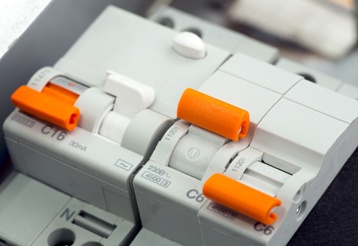Checking the circuit breakers
 Circuit breakers are used to protect electric circuits with a voltage of up to 1000 V from emergency operation. The reliable protection of electrical circuits by these electrical devices is ensured only if the circuit breaker is in good technical condition and its actual operating characteristics correspond to the declared ones. Therefore, the inspection of circuit breakers is one of the mandatory stages of work when commissioning electrical panels for various purposes, as well as during their periodic review. Consider the characteristics of the circuit breaker check.
Circuit breakers are used to protect electric circuits with a voltage of up to 1000 V from emergency operation. The reliable protection of electrical circuits by these electrical devices is ensured only if the circuit breaker is in good technical condition and its actual operating characteristics correspond to the declared ones. Therefore, the inspection of circuit breakers is one of the mandatory stages of work when commissioning electrical panels for various purposes, as well as during their periodic review. Consider the characteristics of the circuit breaker check.
First of all, it is necessary to perform a visual inspection of the device. The required marking must be placed on the body of the circuit breaker, there should be no visible defects, loose parts of the body. It is necessary to perform several operations to manually turn the device on and off.
The machine must be fixed in the on position and be able to be turned off. It is also necessary to pay attention to the quality of the breaker clamps.In the absence of visible damage, continue to check its operation.
The circuit breaker is structurally independent, thermal and electromagnetic release. Circuit breaker testing consists of checking the operation of the listed releases under various conditions. This process is called downloading.
The circuit breakers are loaded on a special test rig, with the help of which the required load current can be applied to the device under test and the time of its operation recorded.
The shunt release closes and opens the breaker contacts when the device is manually closed and opened. Also, this release automatically trips the protection device if it is affected by two other releases that provide overcurrent protection.
Thermal release protects against excess load current flowing through the circuit breaker above the rated value. The main structural element of this edition is bimetallic plate, which heats up and deforms if a load current flows through it.
The plate, deflecting to a certain position, acts on the free trip mechanism, which ensures automatic tripping of the circuit breaker. Also, the response time of the thermal release depends on the load current.

Each type and class of circuit breaker has its own current-time characteristic, which tracks the dependence of the load current on the operating time of the thermal release of that circuit breaker.
When checking the thermal release, several current values are taken, the time during which the automatic tripping of the circuit breaker will occur is recorded.The resulting values are compared with the values from the current-time characteristic for that device. It should be noted that the operating time of the thermal release is affected by the ambient temperature.
In the passport data, the characteristics of the time current for a temperature of 25 ° C are given to the breaker, with an increase in temperature, the response time of the thermal release decreases, and with a decrease in temperature, it increases.
The electromagnetic release serves to protect the electrical circuit from short-circuit currents, currents that significantly exceed the nominal. The magnitude of the current at which this release operates is indicated by the class of the circuit breaker. The class indicates the multiple of the operating current of the electromagnetic release compared to the rated current of the machine.
For example, class «C» indicates that the electromagnetic release will turn off when the rated current is 5-10 times higher. If the rated current of the circuit breaker is 25 A, then the tripping current of its electromagnetic release will be in the range of 125-250 A. This release, unlike the thermal one, must be turned off immediately, in a fraction of a second.
Read also: Breaker device
